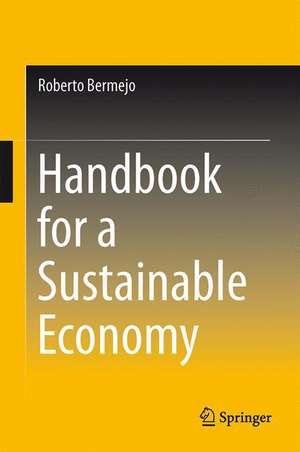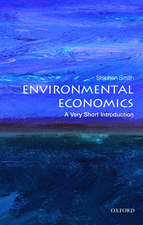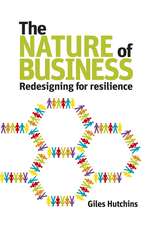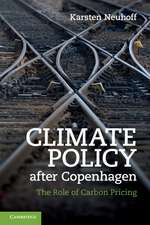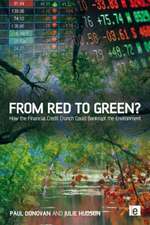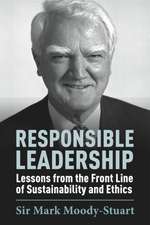Handbook for a Sustainable Economy
Autor Roberto Bermejoen Limba Engleză Hardback – 28 iul 2014
The first section offers a critical analysis of orthodox economical thinking, and the tools used by the conventional economy to solve the “environmental problem.” The author examines the theory and tools of Environmental Economics addressing the commodification of nature, and offers analysis of the theoretical and practical contradictions which arise from attempts to combine environmental protection and free trade.
Part II discusses the principles and tools needed to build a sustainable economy, including the concept of biomimicry as a guiding principle of sustainability, a brief description of the adaptive cycle of ecosystems and explains the concept of transformability and the factors that determine it. Discussion includes a broad evaluation of the capacity for transformation of National Sustainable Development Strategies and an analysis of the essential requirements of ecology-based tax reform. Also included is a critical vision of the dominant paradigm of science and technology.
The third section explores sustainable production and consumption, discussing energy, transport, the circular economy of materials and sustainable consumption. Included are a detailed analysis of factors that determine the limits of fossil fuels, a description of the peak oil structural effect and its sectoral impacts, an overview of a sustainable electric system and a review of biofuels, electricity and hydrogen. The author concludes that only hydrogen associated to fuel offers a sustainable alternative to oil. Discussion includes a view of the structural causes of the current high-level consumption model through the lens ofmotivation, provision and access systems and a detailed description of policies that must be adopted as part of a sustainable consumption strategy.
The final chapter undertakes the task of analyzing the capability of our societies to transform themselves to reach sustainability. The author broadly evaluates each factor, as a prior step to carrying out an overall evaluation and demonstrates that in order to accomplish a comprehensive analysis, a multidisciplinary group is necessary.
| Toate formatele și edițiile | Preț | Express |
|---|---|---|
| Paperback (1) | 586.11 lei 38-44 zile | |
| SPRINGER NETHERLANDS – 27 sep 2016 | 586.11 lei 38-44 zile | |
| Hardback (1) | 956.33 lei 43-57 zile | |
| SPRINGER NETHERLANDS – 28 iul 2014 | 956.33 lei 43-57 zile |
Preț: 956.33 lei
Preț vechi: 1166.26 lei
-18% Nou
Puncte Express: 1434
Preț estimativ în valută:
183.05€ • 198.90$ • 153.86£
183.05€ • 198.90$ • 153.86£
Carte tipărită la comandă
Livrare economică 21 aprilie-05 mai
Preluare comenzi: 021 569.72.76
Specificații
ISBN-13: 9789401789806
ISBN-10: 9401789800
Pagini: 320
Ilustrații: XVI, 400 p. 78 illus., 63 illus. in color.
Dimensiuni: 155 x 235 x 22 mm
Greutate: 0.76 kg
Ediția:2014
Editura: SPRINGER NETHERLANDS
Colecția Springer
Locul publicării:Dordrecht, Netherlands
ISBN-10: 9401789800
Pagini: 320
Ilustrații: XVI, 400 p. 78 illus., 63 illus. in color.
Dimensiuni: 155 x 235 x 22 mm
Greutate: 0.76 kg
Ediția:2014
Editura: SPRINGER NETHERLANDS
Colecția Springer
Locul publicării:Dordrecht, Netherlands
Public țintă
Professional/practitionerCuprins
Part I Critical review of the orthodox economy.- 1 paradigms.- 2 the commodification of nature and its consequences.- 3 Foundations and instruments of environmental economics.- 4 Free market and sustainability.- 5 Sustainable development in the Brundtland report and its distortion.- Part II Principles and instruments for sustainability.- 6 Sustainability of social-economical systems.- 7 Sustainability.- 8 Instruments for sustainability: strategic planning and ecological tax reform.- 9 Science and technology for sustainability.- Part III Sustainable production and consumption.- 10 The limits of fossil fuels.- 11 Repercussions of the end of the oil age.- 12 Towards sustainable transport at the end of the fossil fuels era.- 13 Solar economy elements.- 14 Renewable hydrogen economy.- 15 Societies in energy emergency.- 16 Circular economy.- 17 Industrial ecology.- 18 Basis for an eco-effective and integrated product strategy.- 19 Sustainable consumption.- Part IV Evaluation of transformability.- 20 Overall evaluation of transformability and its trend.
Textul de pe ultima copertă
Since the 1992 World Scientists’ Warning to Humanity, the looming prospect of Earth’s changing climate has inspired a broad movement dedicated to a sustainable future. In this Handbook, the author explains the elements of a sustainable economy, the development of which must be undertaken if we are to retain our civilization.
The first section offers a critical analysis of orthodox economical thinking, and the tools used by the conventional economy to solve the “environmental problem.” The author examines the theory and tools of Environmental Economics addressing the commodification of nature, and offers analysis of the theoretical and practical contradictions which arise from attempts to combine environmental protection and free trade.
Part II discusses the principles and tools needed to build a sustainable economy, including the concept of biomimicry as a guiding principle of sustainability, a brief description of the adaptive cycle of ecosystems, and explains the concept of transformability and the factors that determine it. Discussion includes a broad evaluation of the capacity for transformation of National Sustainable Development Strategies, and an analysis of the essential requirements of ecology-based tax reform. Also included is a critical vision of the dominant paradigm of science and technology.
The third section explores sustainable production and consumption, discussing energy, transport, the circular economy of materials, and sustainable consumption. Included are a detailed analysis of factors that determine the limits of fossil fuels, a description of the peak oil structural effect and its sectoral impacts, an overview of a sustainable electric system, and a review of biofuels, electricity and hydrogen. The author concludes that only hydrogen associated to fuel offers a sustainable alternative to oil. Discussion includes a view of the structural causes of the current high-level consumption model through the lens ofmotivation, provision and access systems, and a detailed description of policies that must be adopted as part of a sustainable consumption strategy.
The final chapter undertakes the task of analyzing the capability of our societies to transform themselves to reach sustainability. The author broadly evaluates each factor, as a prior step to carrying out an overall evaluation, and demonstrates that in order to accomplish a comprehensive analysis, a multidisciplinary group is necessary.
The first section offers a critical analysis of orthodox economical thinking, and the tools used by the conventional economy to solve the “environmental problem.” The author examines the theory and tools of Environmental Economics addressing the commodification of nature, and offers analysis of the theoretical and practical contradictions which arise from attempts to combine environmental protection and free trade.
Part II discusses the principles and tools needed to build a sustainable economy, including the concept of biomimicry as a guiding principle of sustainability, a brief description of the adaptive cycle of ecosystems, and explains the concept of transformability and the factors that determine it. Discussion includes a broad evaluation of the capacity for transformation of National Sustainable Development Strategies, and an analysis of the essential requirements of ecology-based tax reform. Also included is a critical vision of the dominant paradigm of science and technology.
The third section explores sustainable production and consumption, discussing energy, transport, the circular economy of materials, and sustainable consumption. Included are a detailed analysis of factors that determine the limits of fossil fuels, a description of the peak oil structural effect and its sectoral impacts, an overview of a sustainable electric system, and a review of biofuels, electricity and hydrogen. The author concludes that only hydrogen associated to fuel offers a sustainable alternative to oil. Discussion includes a view of the structural causes of the current high-level consumption model through the lens ofmotivation, provision and access systems, and a detailed description of policies that must be adopted as part of a sustainable consumption strategy.
The final chapter undertakes the task of analyzing the capability of our societies to transform themselves to reach sustainability. The author broadly evaluates each factor, as a prior step to carrying out an overall evaluation, and demonstrates that in order to accomplish a comprehensive analysis, a multidisciplinary group is necessary.
Caracteristici
Offers a far-reaching, closely detailed and highly critical analysis of the conventional economy approach to the “environmental problem” Explains and develops the concept of bio mimicry in pursuit of environmental sustainability and provides tools that are necessary to build it Offers a broad and detailed view of today’s fossil fuel energy economy and of alternatives based on renewable energy, hydrogen and improving efficiency Includes supplementary material: sn.pub/extras
